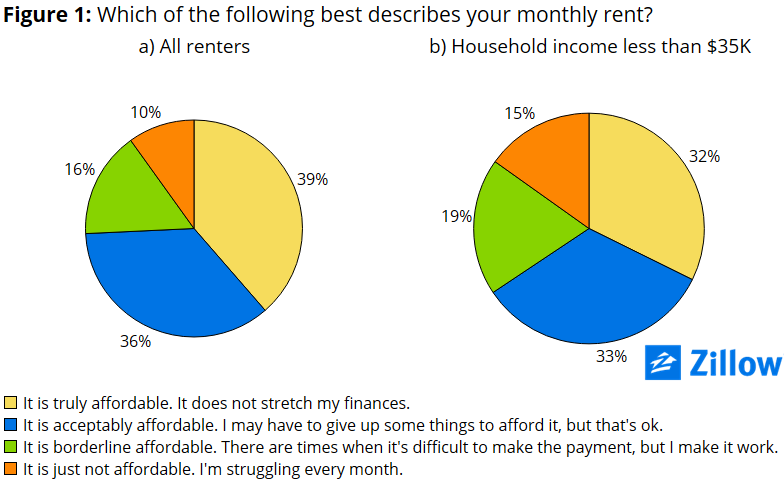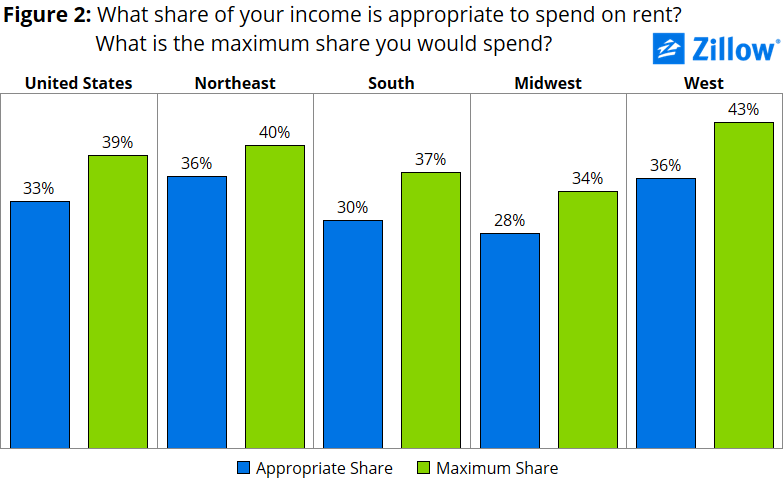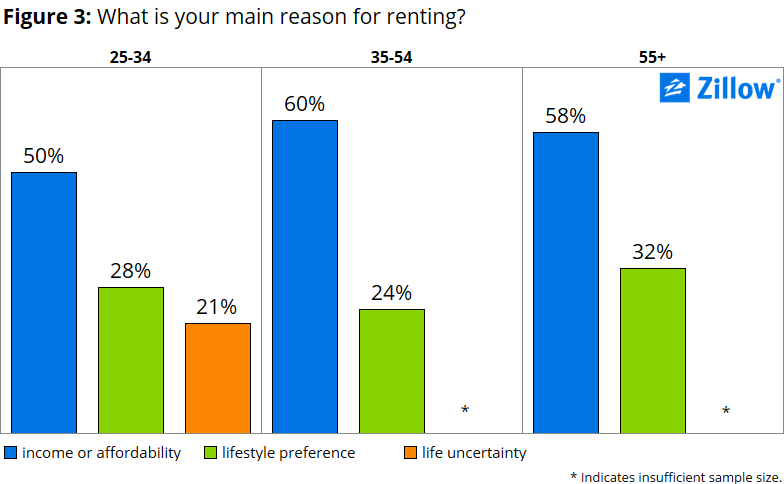- For roughly one-quarter of renters, rents are outright unaffordable or just borderline affordable. Among low-income Americans, more than one-in-seven struggle to pay their rent every month.
- Renters say it is acceptable to pay about 30 percent of their income on rent, and are willing to spend a maximum of about 40 percent. Rent burdens in many U.S. cities exceed those thresholds.
- Income and affordability are the main reasons why most renters choose to rent, especially middle-aged renters.
Deteriorating rental affordability is a pressing national issue, as rents rapidly rise beyond the means of many at the same time as many young adults choose to rent for longer – a combination of preferences and a seeming inability to gain a foothold in the purchase market.
To get a sense of the scope of these challenges, Zillow surveyed renters nationwide, asking how burdensome their rent is, how much of their income they’re willing to pay for rent and why they rent, among other questions. Here are some of our findings:
 More than one-quarter (26 percent) of renters said their monthly rent is either not affordable at all – they struggle to pay rent every month – or only borderline affordable, sometimes difficult to pay but doable (figure 1a).
More than one-quarter (26 percent) of renters said their monthly rent is either not affordable at all – they struggle to pay rent every month – or only borderline affordable, sometimes difficult to pay but doable (figure 1a).
- Among households with an annual household income below $35,000, more than one-third said that their rent is not affordable at all or borderline affordable (figure 1b).
- More than one in seven households (15 percent) with an annual household income below $35,000 said they struggle every month to pay rent.
 In general, Americans said they think it is acceptable to spend roughly one-third of their incomes on rent – in line with professional recommendations (figure 2). However, there are wide regional, racial/ethnic and socio-economic disparities.
In general, Americans said they think it is acceptable to spend roughly one-third of their incomes on rent – in line with professional recommendations (figure 2). However, there are wide regional, racial/ethnic and socio-economic disparities.
- On average, renters in the Northeast and West said they think it is acceptable to spend slightly more (36 percent) of their income on rent, while renters in the Midwest and South think a smaller share (30 percent) is more appropriate.
- Hispanics said they think it’s acceptable to spend a slightly higher share of their incomes on rent than either Whites or Blacks.
- On average, low-income households – those with an annual household income of $35,000 or less – said they think it’s acceptable to spend 36 percent of their income on rent. High income households – those with an annual household income of $100,000 or more – said they think it’s acceptable to spend 23 percent of their income on rent.
- For the highest earning, low-income households (the top of the bottom tier), this would work out to a maximum monthly rent of about $1,060.
- For the lowest-earning, high-income households (in other words, the bottom of the top tier) this would work out to a maximum monthly rent of about $1,940.
Despite their perceptions of what is acceptable, Americans would be willing to spend a higher share – a maximum of almost 40 percent – of their income on rent (figure 2). According to Zillow’s most recent analysis, rent burdens in many U.S. metro areas exceed these thresholds.
- On average, renters in the West said they are willing to spend a maximum of 43 percent of their income on rent, compared to 40 percent in the Northeast, 37 percent in the South and 34 percent in the Midwest.
- Low-income renters – those with an annual household income of $35,000 or less – said they are willing to spend a maximum of 41 percent of their income on rent on average, which would work out to a monthly rent of $1,200 for the highest-earning, low-income renters.
- High-income renters – those with an annual household income of $100,000 or more – said they are willing to spend a maximum of 30 percent of their income on rent, on average, which would work out to a monthly rent of $2,475 for the lowest-earning, high-income earners.
When asked why they choose to rent, more than half (54 percent) of renters cited a lack of income of homeownership affordability concerns. More than a quarter (27 percent) cited a preference for renting, and about one-in-six (16 percent) cited uncertainty in their living situation.[1] The remainder cited other, unrelated reasons.
BY AGE

- Income and affordability concerns were most prevalent among middle-aged renters: 60 percent of renters aged 35 to 54 cited income or affordability concerns, compared to 50 percent of young-adult renters aged 25 to 34 (figure 3).
- Income and affordability were of least concern to senior citizen renters: Only 46 percent cited income or affordability as their reason for renting. Similarly, older renters were most likely to cite living preferences as their reason for renting: 32 percent cited a preference for renting compared to 28 percent of young adults age 25 to 34. (Although sample size was insufficient to examine preference renters among senior citizens age 65 and older, they appear to be even more likely to express a preference for renting rather than an inability to buy a home.)
- More than one in five (21 percent) young-adult renters aged 18 to 34 cited life uncertainty as their reason for renting.
BY REGION
- Income and affordability concerns were most prominent in the West (59 percent) and the Northeast (55 percent), while renters-by-preference are most prominent in the Northeast (29 percent).
- Renters choosing to rent because they said they couldn’t qualify for a loan were most prominent in the West and the South, where 19 percent and 16 percent, respectively, of respondents said that the inability to qualify for a home loan was the main reason why they rented. This may be due, at least in part, to the legacy of the foreclosure crisis, which hit Western and Southern markets very hard.
BY RACE/ETHNICITY
- Less than half (47 percent) of white renters cited income/affordability as their reason for renting, compared to more than two-thirds (68 percent) of Blacks and 58 percent of Hispanics.
BY INCOME & FAMILY
- Perhaps unsurprisingly, low-income renters – those with an annual household income of $35,000 or less – overwhelmingly (61 percent) cited income and affordability concerns as their main reason for renting.
- 70 percent of households who cited income and affordability as their main reason for renting said their rent is not at all affordable or only borderline affordable, compared to 48 percent of renters who said that their rent is acceptably affordable. These renters are being hit double – by crushingly high rents and an inability to escape renting.
- Middle-income renters – those with annual household incomes between $50,000 and $75,000 – were most likely to cite renting because of lifestyle preferences (39 percent).
Methodology
The data presented in this report are the results of a voluntary online omnibus survey of 1,024 adults age 18 and older, including 370 renters, conducted on behalf of Zillow by ORC International. The survey was conducted between March 26 and March 29, 2015. Responses are weighted by age, sex, geographic region, rate and education to ensure a reliable and accurate representation of the U.S. population. All sample surveys and polls may be subject to multiple sources of error, including but not limited to sampling error, coverage error, error associated with nonresponse, error associated with question wording and response options and post-survey weighting and adjustments.
[1] Respondents were provided with 10 options in response to the question, “Which of the following reasons best describes why you currently rent?” Responses grouped into the category “income/affordability” include (1) “Because I can’t afford the maintenance, taxes and monthly payments of homeownership,” (2) “Because I can’t qualify for a home loan,” (3) “Because I don’t have a down payment saved for a home,” and (4) “I receive government assistance with my rent.” Responses grouped into the category “preference” include (1) “I simply prefer to rent”, (2) “I could afford to buy a home, but not the size or style or location that I would want,” and (3) “I like the amenities in my rental community/complex.” Responses grouped into the category “uncertainty” include (1) “I’m not certain how long I will live here, and/or I’m only living here for a short time,” and (2) “I recently sold my home and have not yet found another to buy.”


 More than one-quarter (26 percent) of renters said their monthly rent is either not affordable at all – they struggle to pay rent every month – or only borderline affordable, sometimes difficult to pay but doable (figure 1a).
More than one-quarter (26 percent) of renters said their monthly rent is either not affordable at all – they struggle to pay rent every month – or only borderline affordable, sometimes difficult to pay but doable (figure 1a). In general, Americans said they think it is acceptable to spend roughly one-third of their incomes on rent – in line with professional recommendations (figure 2). However, there are wide regional, racial/ethnic and socio-economic disparities.
In general, Americans said they think it is acceptable to spend roughly one-third of their incomes on rent – in line with professional recommendations (figure 2). However, there are wide regional, racial/ethnic and socio-economic disparities.